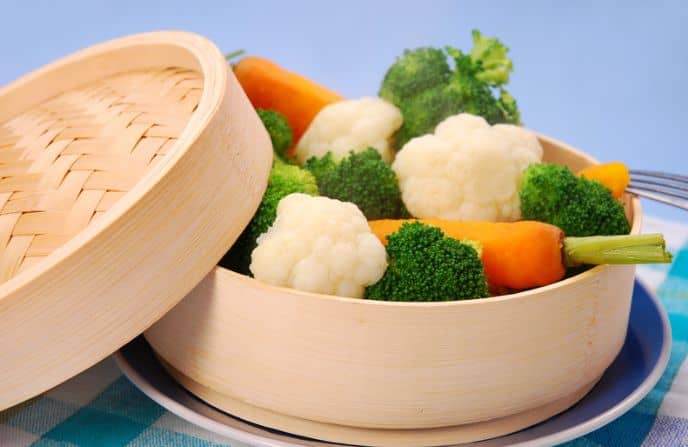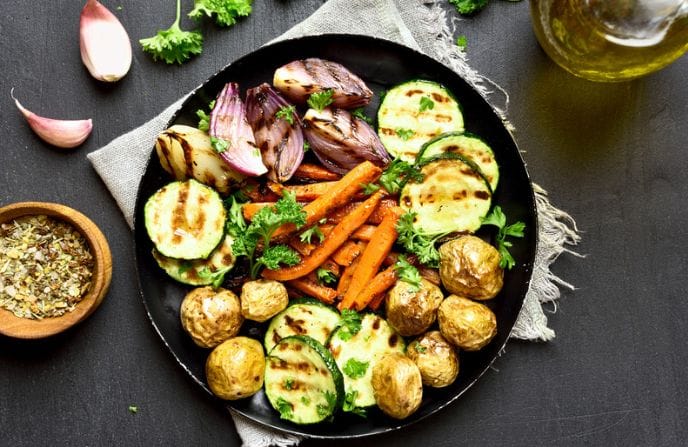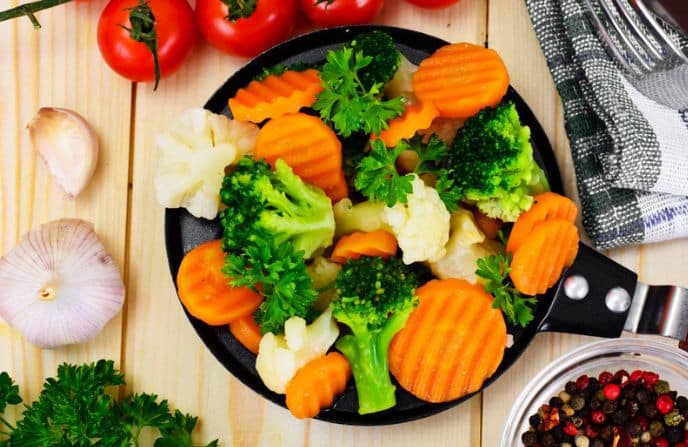Eating your vegetables is one of the best things you can do for your health, but did you know that how you cook them is also important? Different cooking methods affect different nutrients, so it’s essential to know which method is the healthiest way to prepare your veggies.
So what’s the healthiest way to cook vegetables? It is to steam them until they are just tender, and then remove them from the heat immediately. This will help to ensure that they retain the maximum amount of nutritional value.
Here’s a look at why steaming is the best way to cook vegetables and some tips for getting the most out of your steamed veggies.
Different Cooking Methods
When it comes to cooking vegetables, there are a variety of methods to choose from. Some methods are healthier than others. For instance, steaming or boiling vegetables preserves more of their nutrients than frying or sauteing. Sauteing or frying vegetables is a popular cooking technique that can add lots of flavor and texture to your dish. But what are the pros and cons of each cooking method?
-
Steaming

Steaming is a cooking method that uses hot steam from boiling water to cook food. It’s considered one of the healthiest ways to prepare vegetables because it preserves more of their natural nutrients, flavors, and colors than other methods such as boiling or frying. It preserves more vitamins and minerals than boiling or microwaving.
In addition, it is important to avoid overcooking vegetables, as this can also lead to the loss of nutrients. It also keeps them crunchy and full of flavor. Additionally, it’s a quick and easy method that requires minimal cleanup.
Steaming is a simple process that requires just a few items: a pot, water, and vegetables. Fill the pot with about two inches of water and place it on the stove to boil. Once boiling, add your vegetables to a steamer basket or insert that fits inside the pot, cover it with a lid, and reduce the heat to low-medium (around 3-4).
Let steam for 5-15 minutes, or until the vegetables are tender. In addition, it is important to avoid overcooking vegetables, as this can also lead to the loss of nutrients.
-
Roasting

Roasting vegetables is a great way to bring out their natural flavor. The high heat of the oven caramelizes the sugars in the vegetables, resulting in a sweet and savory dish. Plus, roasting is a relatively healthy cooking method, as it doesn’t require the use of large amounts of oil. However, you should be careful not to overdo it on the oil – too much can make your roasted veggies greasy and unhealthy. When done right, roasting is a delicious and nutritious way to enjoy your favorite vegetables.
Vegetables that are good for roasting include potatoes, carrots, Brussels sprouts, and cauliflower. To roast vegetables, simply toss them in a bit of oil and season them with salt and pepper. Then, bake them in a preheated oven until they’re tender and lightly browned. Roasting vegetables is a quick and easy way to make a delicious side dish – give it a try sometime!
-
Boiling

Boiling is one of the quickest and easiest ways to cook vegetables. However, it’s not the best method if you’re looking to preserve nutrients. Boiling can leach some of the nutrients out of vegetables and into the water. This means that you’re not getting all of the nutrition that you could be. When vegetables are boiled, they can lose a significant amount of water-soluble vitamins, such as Vitamin C and B vitamins.
Additionally, frequent boiling can lead to the breakdown of delicate vitamins and minerals. If you do choose to boil your vegetables, be sure to use the cooking water in another dish, such as a soup or stew. This will help to ensure that you don’t waste any of the nutrients that have been cooked out of the vegetables.
-
Stir-frying

Stir-frying is a popular cooking method that involves quickly cooking food in a small amount of hot oil. Stir-frying vegetables can be healthy if you use a minimal amount of oil and cooked them for a short period of time. This will help to prevent the veggies from becoming greasy or overcooked. While stir-frying can be a healthy way to cook vegetables, there are a few things to keep in mind to make sure your meal is as healthy as possible.
First, use a minimal amount of oil – just enough to coat the bottom of the pan. Second, cook the vegetables for a short period of time – no more than a few minutes. This will help to preserve their nutrients and prevent them from becoming overcooked and mushy. Finally, be sure to use fresh vegetables – frozen or canned vegetables may not be as healthy.
Some of the best veggies for stir-frying include broccoli, carrots, peppers, and mushrooms. By following these tips, you can enjoy a healthy, delicious stir-fry that is packed with nutrients.
-
Microwave

It’s no secret that microwaves make cooking food much easier and faster. In fact, they’re so convenient that many people use them exclusively for heating up leftovers or prepackaged meals. However, microwaves can actually be quite handy for cooking fresh food as well. For example, they’re great for quickly cooking vegetables. Just add a little water to a microwave-safe dish, cover it, and cook on high for a few minutes.
Broccoli, carrots, green beans, and Brussels sprouts are all great veggies to cook in the microwave. Not only is this method quick and easy, but it also helps to preserve the nutritional value of your vegetables. So next time you need a quick and healthy veggie fix, try cooking them in the microwave! You’ll have perfectly cooked veggies in no time. Plus, there’s no need to worry about making a mess on the stovetop.
How to Make Steamed Vegetables Taste Good
If you’ve ever had the misfortune of eating a bland, watery vegetable, you know how important it is to find ways to make them more flavorful. If you’re looking for a way to make your steamed vegetables taste better, there are a few things you can do.

-
Add some seasonings
Try to add some seasonings to your vegetables before steaming them. This can include anything from salt and pepper to herbs and spices, such as rosemary, thyme, and garlic. You can also add a bit of butter or olive oil to your steamed veggies, which will help to retain their flavor. A splash of lemon juice or vinegar is also great for extra flavor. Don’t be afraid to experiment with different seasonings until you find a combination that you like.
-
Steam your veggies in broth

Steam your veggies in broth for a quick and easy way to cook them up with a big flavor! The broth gives your vegetables the freedom to simmer in all of their natural juices, leaving them soft and full of flavor. By slowly cooking veggies in broth, you’re also able to add more spices and flavors that will infuse into the vegetables for an even tastier experience. Not only is it a tasty and healthy alternative to other types of cooking but it’s also quick and simple; perfect for a busy day or when short on time.
-
Don’t overcook your veggies
When over-cooked, veggies lose many of their vital nutrients and health benefits. The best way to ensure that you’re getting all the nutrition is to steam or stir-fry them in the shortest amount of time possible, or even eat them raw if possible. Doing this will keep the flavor without jeopardizing your health. Eating undercooked vegetables can get boring though, so feel free to mix veggies up with other herbs and spices and experiment with different flavors. Don’t be afraid to play around in the kitchen!
-
Steam with other ingredients
Cooking with steam is a great way to enhance flavor, especially when combined with more fragrant ingredients. Add some vegetables that have more flavor, such as onions, tomatoes, or mushrooms. Steam preserves and even intensifies the unique tastes in a variety of different food, while also locking in moisture. Combining this cooking method with ingredients like aromatic herbs, chilis, or even citrus can create an incredibly flavorful dish.
The key to unlocking the full potential of steaming lies in finding the right balance of these ingredients, adding just enough to lift and balance the natural taste of whatever you’re cooking up. Whether it’s seafood or soup, steamed dishes that incorporate other great flavors are sure to tantalize any palate.
-
Dips and sauces

A flavorful dipping sauce really is a lifesaver when it comes to boring steamed vegetables. It’s amazing how something so simple can completely transform the flavor and texture of vegetables, making them the highlight of a meal. Learn how to eat more vegetables here.
Not only does a delicious sauce give vegetables that extra depth of flavor and make them infinitely more exciting, but you can also get creative with your ingredients – experiment with different herbs and spices, or kick things up with some chili peppers for a spicy, tangy dip. With the right side dish, you can make even the most mundane veggies into something truly enjoyable.
-
Salting vegetables

This can help draw out their water and make them more flavorful, allowing the flavors to concentrate. As a result, your veggies will be more flavorful and enjoyable. So next time you’re looking for ways to spice up your meals, don’t forget the power of salt.
So next time you’re feeling uninspired by your steamer, remember that a few simple modifications can make all the difference. With a little effort, you can turn steamed veggies into a delicious and healthy meal.
How Long Should I Steam Vegetables?
Choosing the right cooking time for your veggies can be a bit of a guessing game – especially when it comes to streaming. If you’re new to steaming, or just want to brush up on your veggie-cooking skills, here are a few general guidelines to keep in mind. For most vegetables, you’ll want to steam them for 3-5 minutes.
This will ensure that they’re cooked through but still retain some of their crunches. However, there are a few exceptions. For example, more delicate veggies like broccoli and asparagus only need 2-3 minutes of steaming, while heartier vegetables like carrots and potatoes may need 5-7 minutes. As always, use your best judgment and adjust the cooking time as needed based on the vegetables you’re working with.
How long should I steam broccoli?
Steaming is a quick and easy way to cook broccoli while preserving its nutrients. How long you steam broccoli depends on how tender you want it to be. If you like your broccoli crispy, then you’ll only need to steam it for a few minutes. However, if you prefer your broccoli to be soft, then you’ll need to steam it for longer. The key is to not overcook the broccoli, which can make it mushy. For crisp-tender broccoli, start by bringing a pot of water to a boil. Then add the broccoli and let it steam for 3 to 5 minutes. You can also add a pinch of salt to the water for flavor. The best way to tell when broccoli is done steaming is to poke it with a fork. If the fork easily pierces the broccoli, then it is ready to eat. If the broccoli is tough and difficult to pierce, then it needs to be steamed for longer. When in doubt, err on the side of longer cooking times, as overcooked broccoli is still edible, but undercooked broccoli can be hard and difficult to chew. When the broccoli is done, remove it from the pot with a slotted spoon and enjoy.
How long should I steam cauliflower?
When it comes to steaming cauliflower, there is no one-size-fits-all answer. The cooking time will depend on the size and density of the cauliflower, as well as your personal preferences. For a head of cauliflower, start by cutting it into florets. If the florets are large, you may want to cut them in half or quarters. Then, bring a pot of water to a boil and place a steamer basket over top. Add the cauliflower to the basket and cover the pot. Steam for 5-7 minutes, or until the cauliflower is tender. Keep in mind that longer cooking times will result in softer florets. If you prefer your cauliflower to have a bit of crunch, err on the side of shorter cooking times. You can always steam for longer if needed. Finally, remove the pot from the heat and carefully lift out the steamer basket. Serve immediately while hot.
How long should I steam potatoes?
When it comes to steaming potatoes, the key is to not overdo it. You don’t want to end up with mushy potatoes, after all. The general rule of thumb is to steam them for about 15 minutes. Of course, this will vary depending on the size and type of potato you’re using. For instance, Yukon Gold potatoes will take a little longer to steam than red potatoes. And if you’re steaming small potatoes, they’ll obviously need less time than larger ones. So it’s always best to check on them periodically and give them a poke with a fork to see if they’re done to your liking. But in most cases, 15 minutes should be just about right.
How long should I steam carrots?
The answer to this question depends on how you like your carrots. If you like them soft, then you’ll want to steam them for about 3-5 minutes. If you like them slightly firmer, then 2-3 minutes should do the trick. Just put your carrots in a steamer basket over boiling water, cover, and let them cook until they’re done to your liking. Keep in mind that the longer you steam them, the more nutrients will be lost, so if you’re looking to get the most out of your carrots, don’t steam them for too long. When they’re done, just remove them from the heat and enjoy!
How long should I steam asparagus?
Asparagus is a delicious and healthy vegetable that can be enjoyed cooked or raw. For those who prefer cooked asparagus, steaming is a popular method of preparation. But how long should you steam asparagus to ensure that it is cooked through but still retains its crisp texture? The answer may surprise you. According to the experts, asparagus only needs to be steamed for 3-4 minutes. This quick cooking time helps to preserve the nutrient content of the asparagus while still allowing it to retain its flavor and texture. So next time you’re in the mood for some steamed asparagus, remember that less is more. A few minutes in the steamer will give you the perfect result.
How long should I steam corn on the cob?
When it comes to steaming corn on the cob, there are a few things to keep in mind. First, you’ll want to make sure that the ears of corn are fresh and in season – this will help to ensure that they’re nice and sweet. Second, you’ll need to decide how many ears of corn you want to cook. If you’re cooking for a large group, you may need to steam the corn in batches. Once you’ve got your corn ready to go, it’s time to start steaming. For most people, 4 minutes is the perfect amount of time – this will give the corn a nice, tender texture. Of course, if you prefer your corn a bit more cooked, feel free to steam it for a few minutes longer. When it’s done, simply add butter and salt to taste and enjoy!
How long should I steam green beans?
Steaming green beans helps to preserve their nutrients while cooking them quickly and evenly. To steam green beans, you will need a pot with a tight-fitting lid and a steamer basket. Fill the pot with enough water to reach the bottom of the steamer basket, then bring the water to a boil. Add the green beans to the basket, cover the pot, and let them steam for 3 to 5 minutes, or until they are tender but still crisp. Once they are done, remove them from the pot and enjoy!
Conclusion
Cooking vegetables doesn’t have to be a daunting task. In fact, it can be quite simple and easy with the right methods. Different cooking methods will produce different flavors and textures in your vegetables. If you’re looking for a healthy cooking method that doesn’t require too much effort, then steaming is your best option. However, if you want to roast your vegetables instead, just be sure not to use too much oil and cook them for a short period of time. And if you’re looking for a way to add flavor to your veggies, try salting them before cooking.
